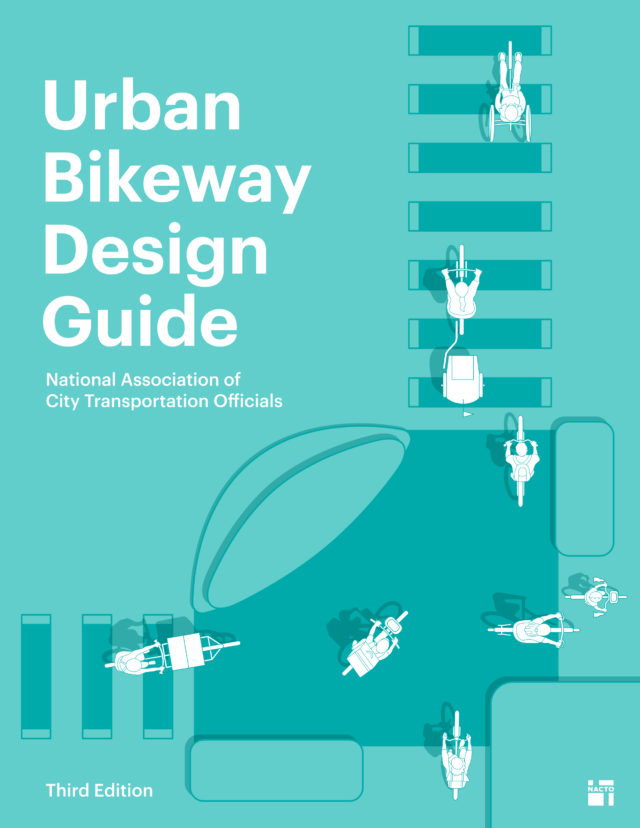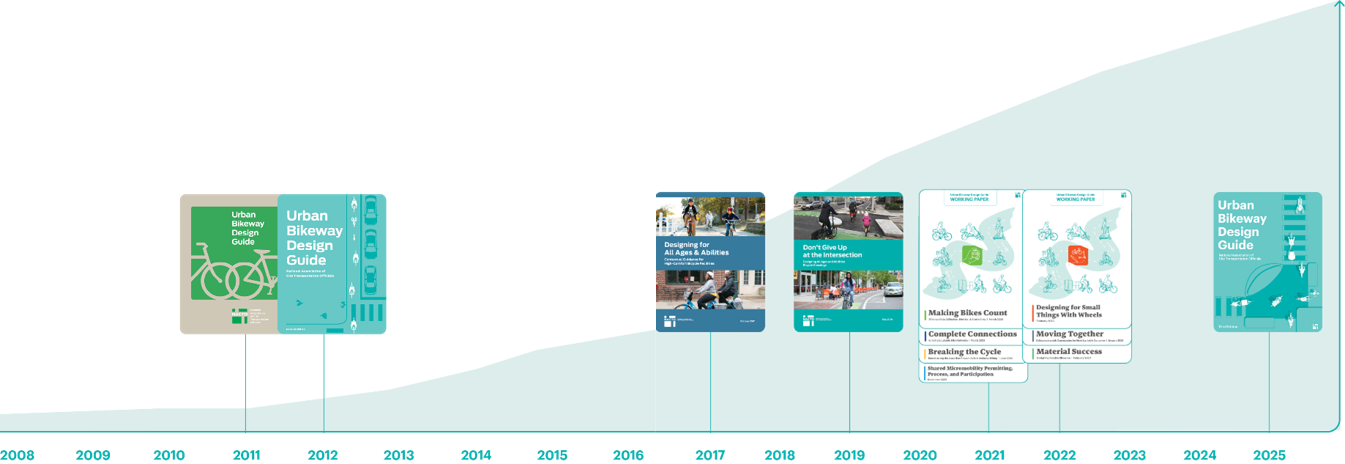Over a decade ago, cities banded together to develop a first-of-its-kind document: bikeway design guidance developed by cities, for cities. Released in 2011, the NACTO Urban Bikeway Design Guide sparked a design revolution in cities across North America. City streets are now understood as key elements in confronting the intertwined safety, equity, and climate crises.
 It’s time for an updated standard for designing streets for bikes. The third edition of the Urban Bikeway Design Guide–developed for cities, by cities–sets this standard, capturing lessons learned and new practices that have emerged in the decade since NACTO published the second edition.
It’s time for an updated standard for designing streets for bikes. The third edition of the Urban Bikeway Design Guide–developed for cities, by cities–sets this standard, capturing lessons learned and new practices that have emerged in the decade since NACTO published the second edition.
The Urban Bikeway Design Guide, Third Edition, will be published on January 14, 2025. (But you can already pre-order it here!)
The Urban Bikeway Design Guide, Third Edition, will help city leaders and street designers create bikeable cities for people of all ages and abilities. It is a blueprint for implementing safe, connected, and equitable bike networks. It covers city policy, network planning, community collaboration, program and project evaluation, bikeway design, curb management, intersection design, maintenance, and operations. Designs and concepts are spotlit with precise, actionable illustrations and diagrams.
As U.S. Secretary of Transportation Pete Buttigieg put it: “the newest edition of the Urban Bikeway Design Guide will be an important resource for communities as they improve safety and design for cyclists, pedestrians, and everyone who uses our streets and roads.”
Read the Urban Bikeway Design Guide, Second Edition >
Pre-order the Urban Bikeway Design Guide, Third Edition >
Learn more on the Cities for Cycling webpage >
Origins of the Urban Bikeway Design Guide
Biking has never been more popular: bike share systems across the country have record ridership, and bike shops are reporting months-long delays in obtaining new bikes to meet the demand for this increasingly popular transportation option.
Amidst this background, it’s hard to remember that just 15 years ago, there were only 26 miles of protected bike lanes on city streets across the US, in comparison to hundreds today. While cities have always been engines of innovation, little more than a decade ago there was no codified resource for the new strategies and designs that cities were creating to make biking safe and comfortable, no manual guiding cities in how to implement these new designs in different settings.
And then, in 2010, NACTO released a first-of-its-kind guidance–developed by cities, for cities–giving cities the tools and a permission slip to build better bikeways on their streets. For the first time, cities were collectively codifying a new vision for city streets: safe, vibrant, and inviting to bike on, based on designs created by cities. We helped to collect, vet, and standardize these new treatments, formalizing them into a resource endorsed by U.S. DOT and dozens of cities and states across the country. And by doing so, we collectively cracked the door open for a conversation about the role of city streets, and how they can meet our residents’ needs and cities’ goals more effectively.

Timeline: History of the Urban Bikeway Design Guide and protected bike lane mileage in the U.S.
The Expansion and Evolution of NACTO guidance
Over the years, even the most innovative ideas get eclipsed by innovative ground-up thinking. And so, over the past few years NACTO has expanded the Urban Bikeway Design Guide. We brought our city network together to codify what types of treatments work best where, in Designing for All Ages and Abilities (2017) and Don’t Give Up at the Intersection (2019).
Over 2022 and 2023, NACTO published seven working papers addressing the most critical issues cities face while building bike networks that address today’s needs. The papers, which informed the new edition of the guide, covered best practices for data collection, network design, equitable network design, and scaling success:
Using what cities have collectively developed, from the first editions of the bike guide, to the working papers, and more, the third edition of the Urban Bikeway Design Guide will be, as always, built by cities for cities, pushing streets forward to meet the needs of our time.
We’re excited to share the first installment of the next evolution of bike design guidance after the new year. What was once unimaginable is now routine, with millions riding bikes and scooters every year to work, to school, to meet friends, and for doctors appointments. Cities are at their best when they meet the needs of their residents, and we’re proud to work together to raise the state of the practice yet again.